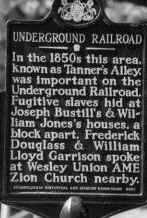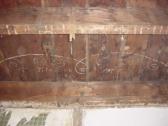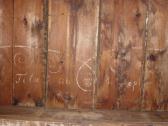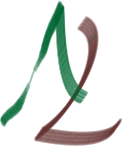|

|
to
seek
freedom...
the Underground
Railroad
in Central Pennsylvania
|
UGRR
markings? page 2
|
|
This is page two of an examination of markings discovered during the
renovation of a circa-1803 farmhouse in Chester County. For the
beginning of this discussion,
click here.
|
|
More
Clues--the design
|
Aside from the text, the actual design also gives us
some clues as to the meaning of the markings, and its origin.
 
Please click the images above for large versions. |
|
Face
of a Fila?
|
If our hypothesis that the sentence "Fila bite the
people" refers to the dog breed
Fila Brasileiro, then it stands to reason that the image of a face within the
central loop is that of a Fila. The drawing, however, only faintly
resembles the head of this muscular hunting dog.
Although the image shows what could be described as similar eyes and
loose furrows of skin in the forehead, the ears are wrong and the
overall image is too human-like. It almost seems to be an image of
a demon. Whether the image is meant to portray the dog as demonic,
or whether it portrays something or someone completely different is
unknown.
|
|
Rams
Horns--
the dwennimmen
|
The six curls beneath the loop closely resemble the
curls of the West African dwennimmen,
an Adinkra symbol for humility, strength, wisdom and
learning. The traditional interpretation of this symbol tells
us that strength must be drawn from the heart (wisdom and learning)
rather than from inherent physical characteristics. Thus the ram,
though he possesses strong horns, seldom uses them in anger
(humility). In this context, the symbols may be saying that
fugitives must use their wits to survive, rather than wage a futile
physical fight.
Note though that the dwennimmen is square, rather than
stretched out in an undulating line as seen here.
|
|
Voudon
symbolism
|
Although voudon ceremonies typically may involve symbols drawn in chalk,
this image does not fit the ritualistic pattern. Traditional
voudon symbols (veve) are highly complex, usually drawn on the floor,
not on the wall. However some Haitian homes do have elaborate veve
on the walls.
Because of the tremendous variations in Voudon practice, this line of
research is currently inconclusive.
|
|
Other notes
|
The sentence shows that at least one person was
literate, a set of skills that varied in existence among fugitive
slaves. The structure of the sentence suggests pidgin or Creole
English, common among slaves brought to the United States from the
Caribbean.
Next page--the
email chain
|
more email |
|
Your
comments
|
We would like to obtain additional information regarding these markings,
to prove or disprove their significance to Underground Railroad history.
If you have information, comments or observations that you think are
useful in helping to identify the markings, please email your comments
to .
|
Submit Comments |
Afrolumens Project Home | Underground Railroad Main
Page
|
